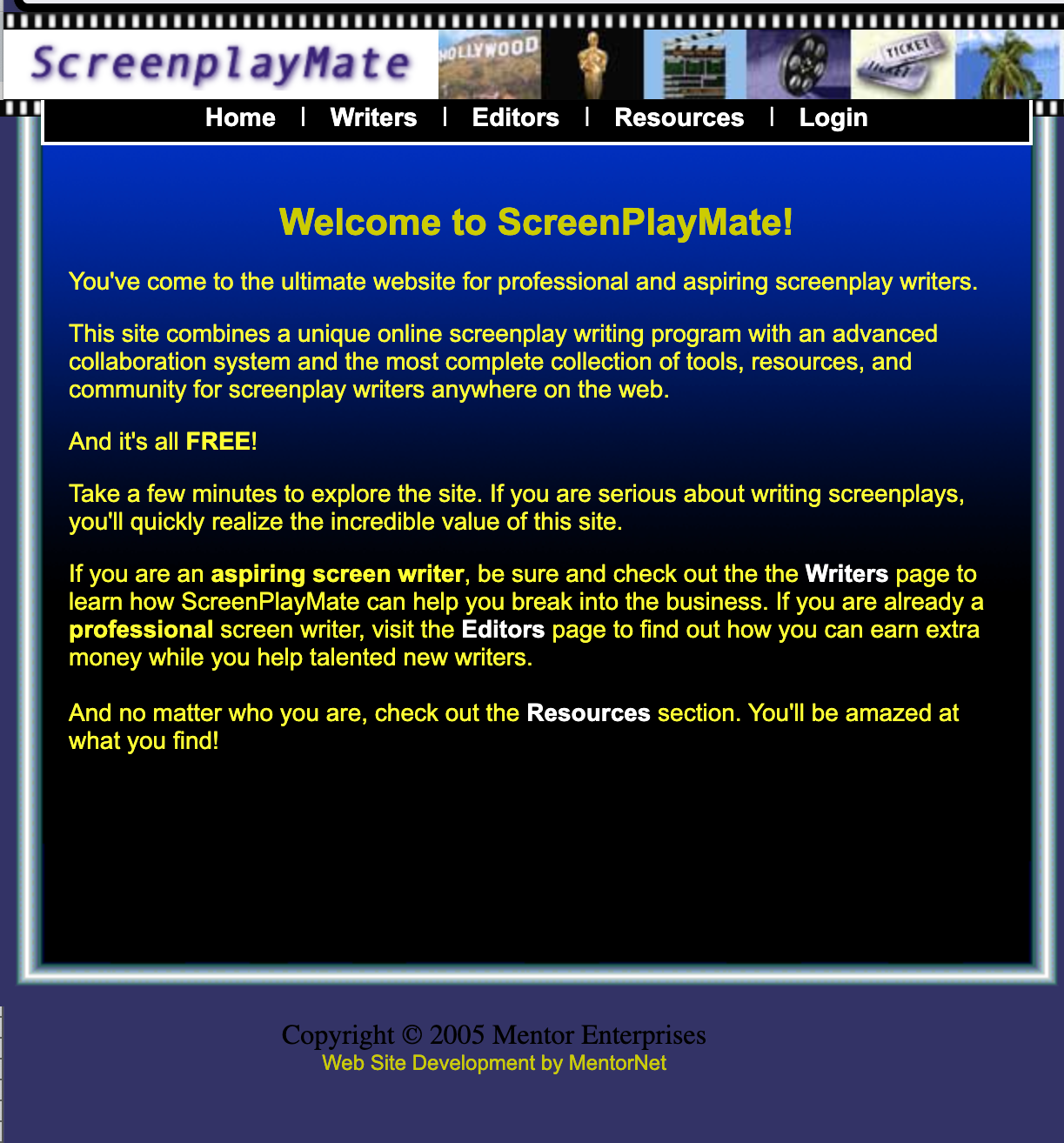ScreenPlayMate
ScreenPlayMate will be a collaborative screenplay writing application with a native game layer that allows teams to accurately track their respective contributions to the project. This platform will be integrated with the ReelCred coin minting system to enable the engage-to-earn business model of the Strands project.
ScreenPlayMate is a platform that Dane has had in mind since at least as early as 2005. He spent 100’s of hours coding away at a web-based screenplay writing application, with intentions of gamifying it in a manner similar to how it is envisioned today. Life circumstances prevented him from accomplishing his vision of a collaborative screenwriting tool at that time.
Today, this innovative concept is even more relevant than it was then.

ScreenPlayMate Development Plan
1. Technology Stack Selection
- Frontend: React.js or Vue.js for dynamic user interfaces.
- Backend: Node.js with Express.js for scalable server-side operations.
- Database: PostgreSQL for relational data and Redis for caching.
- Real-Time Collaboration: WebSockets (e.g., Socket.io) or WebRTC for low-latency communication.
- Authentication: OAuth 2.0 integration with providers like Google and Apple.
- Cloud Services: AWS or Google Cloud for hosting, storage, and CI/CD pipelines.
2. Feature Development Phases
- Phase 1: Core Functionality
- Script editor with real-time collaboration.
- User authentication and project management.
- Basic formatting tools.
- Phase 2: Advanced Features
- Revision history and version control.
- Commenting system and chat integration.
- Offline access with syncing capabilities.
- Phase 3: Enhancements
- Mobile application development.
- Integration with third-party tools (e.g., cloud storage).
- AI-assisted writing suggestions and analytics.
3. Design & User Experience
- Develop wireframes and prototypes using tools like Figma.
- Conduct user testing sessions to gather feedback and iterate on designs.
- Ensure accessibility standards are met.
💰 Cost Estimation
Assuming a development team with the following composition:
- Frontend Developer: 1
- Backend Developer: 1
- Full-Stack Developer: 1
- UI/UX Designer: 1
- QA Engineer: 1
- Project Manager: 1
1. Development Timeline
- Phase 1: 6 weeks
- Phase 2: 4 weeks
- Phase 3: 4 weeks
Total: 14 weeks
2. Hourly Rate
- $30/hour per team member
3. Monthly Cost
- 6 team members × 160 hours/month × $30/hour = $28,800/month
4. Total Development Cost
- $28,800/month × 3.5 months = $100,800
5. Additional Expenses
- Cloud Services: $500/month × 3.5 months = $1,750
- Third-Party Integrations: $1,000
Total Additional Expenses: $2,750
Grand Total Estimated Cost: $100,800 + $2,750 = $103,550
Functional Specification
Overview
ScreenPlayMate is envisioned as a collaborative, gamified screenwriting platform integral to the Strands project. It aims to facilitate community-driven screenplay development, integrating blockchain-based incentives and governance mechanisms. The MVP focuses on core functionalities to enable immediate collaboration, engagement tracking, and administrative oversight.
1. User Management
-
Authentication & Authorization
-
User registration and login via email/password.
-
OAuth integration with platforms like Google and Discord.
-
Role-based access control: Admin, Collaborator, Viewer.
-
-
Profile Management
-
User profiles displaying activity stats, XP, and badges.
-
Editable personal information and preferences.
-
2. Project & Script Management
-
Project Creation
-
Initiate new screenplay projects with titles and descriptions.
-
Assign collaborators with specific roles and permissions.
-
-
Script Editor Integration
-
Embed or link to external script editors (e.g., Arc Studio) for real-time collaboration.
-
Support for importing/exporting scripts in standard formats like .fdx and Fountain.
-
-
Version Control
-
Track changes and maintain revision history.
-
Ability to revert to previous versions.
-
3. Gamification Layer
-
Activity Tracking
-
Monitor user actions such as writing, editing, commenting, and reviewing.
-
Assign XP points based on predefined activity metrics.
-
-
Leaderboards
-
Display rankings based on XP accumulation.
-
Filterable by time frames (daily, weekly, all-time).
-
-
Achievements & Badges
-
Award badges for milestones (e.g., first script, 10,000 words written).
-
Display badges on user profiles.
-
4. Administrative Dashboard
-
User Management
-
View and manage user accounts and roles.
-
Suspend or revoke access as necessary.
-
-
XP Configuration
-
Define and adjust point values for various activities.
-
Set thresholds for achievements and badges.
-
-
Analytics & Reporting
-
Generate reports on user engagement, script progress, and platform usage.
-
Visual dashboards displaying key metrics.
-
5. Integration with Strands Ecosystem
-
Tokenomics
-
Link XP accumulation to $STRAND token rewards.
-
Implement mechanisms for token distribution based on activity.
-
-
Governance
-
Integrate with Snapshot for proposal creation and voting.
-
Allow users to stake tokens for governance participation.
-
6. Technical Specifications
-
Frontend
-
Framework: React.js.
-
Responsive design for desktop and mobile.
-
State management with Redux or Context API.
-
-
Backend
-
Runtime: Node.js with Express.js.
-
RESTful API development.
-
Authentication with JWT.
-
-
Database
-
Relational Database: PostgreSQL.
-
ORM: Sequelize or Prisma.
-
-
DevOps
7. Security & Compliance
-
Data Protection
-
Access Control
-
Implement strict role-based permissions.
-
Monitor and log administrative actions.
-
8. Timeline & Resource Allocation
-
Estimated Development Time: 14 weeks.
-
Team Composition:
9. Future Enhancements (Post-MVP)
-
Real-Time Collaboration
-
Implement in-house script editor with live collaboration features.
-
-
Advanced Gamification
-
Introduce quests, challenges, and seasonal events.
-
-
Mobile Application
-
Develop native apps for iOS and Android platforms.
-
-
AI Integration
-
Incorporate AI tools for script suggestions and grammar checks.
-
